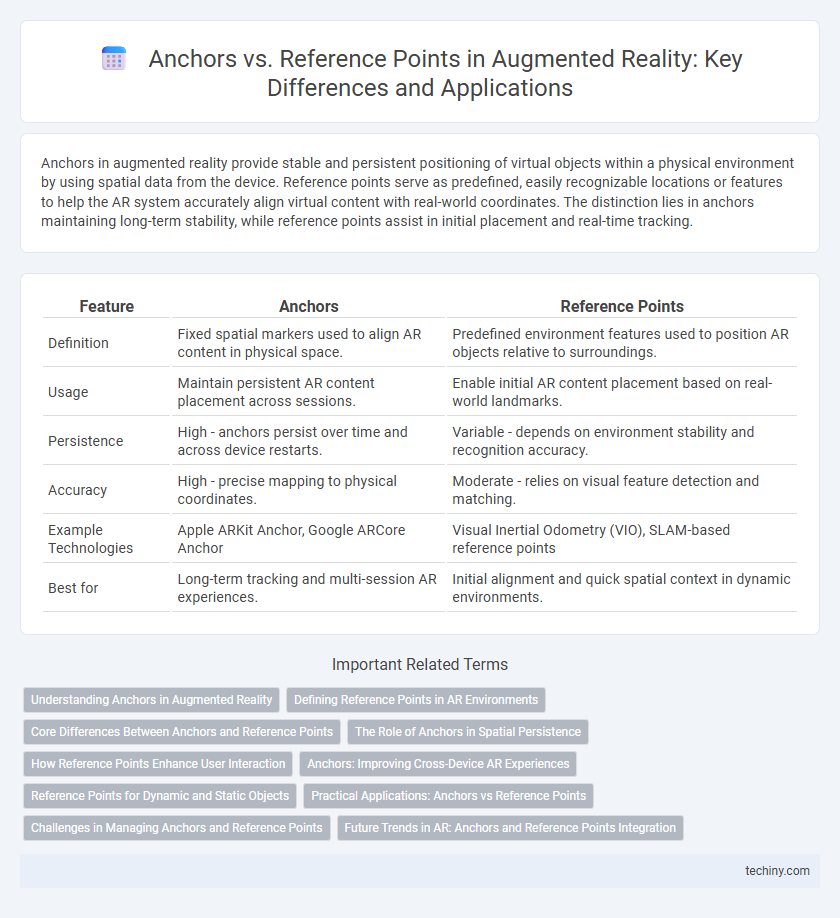Anchors in augmented reality provide stable and persistent positioning of virtual objects within a physical environment by using spatial data from the device. Reference points serve as predefined, easily recognizable locations or features to help the AR system accurately align virtual content with real-world coordinates. The distinction lies in anchors maintaining long-term stability, while reference points assist in initial placement and real-time tracking.
Table of Comparison
| Feature | Anchors | Reference Points |
|---|---|---|
| Definition | Fixed spatial markers used to align AR content in physical space. | Predefined environment features used to position AR objects relative to surroundings. |
| Usage | Maintain persistent AR content placement across sessions. | Enable initial AR content placement based on real-world landmarks. |
| Persistence | High - anchors persist over time and across device restarts. | Variable - depends on environment stability and recognition accuracy. |
| Accuracy | High - precise mapping to physical coordinates. | Moderate - relies on visual feature detection and matching. |
| Example Technologies | Apple ARKit Anchor, Google ARCore Anchor | Visual Inertial Odometry (VIO), SLAM-based reference points |
| Best for | Long-term tracking and multi-session AR experiences. | Initial alignment and quick spatial context in dynamic environments. |
Understanding Anchors in Augmented Reality
Anchors in augmented reality serve as stable, real-world reference positions that enable virtual objects to maintain consistent placement across different user sessions and environments. They leverage spatial mapping and sensor data to track and lock digital content to specific physical locations, ensuring accurate alignment and persistent interaction. Unlike basic reference points, anchors provide a dynamic, context-aware foundation critical for immersive AR experiences and robust environmental integration.
Defining Reference Points in AR Environments
Reference points in augmented reality (AR) environments serve as fixed, identifiable locations or objects in the physical world used to establish spatial context for virtual content placement. Unlike anchors, which are dynamic and continuously updated to maintain alignment between virtual and real-world elements, reference points provide a stable foundation for AR systems to map and track the environment. Precise identification and utilization of reference points enable accurate positioning, orientation, and interaction of AR objects, enhancing user experience and spatial awareness.
Core Differences Between Anchors and Reference Points
Anchors in augmented reality provide persistent spatial positioning by associating virtual content with real-world locations, enabling consistent placement across sessions. Reference points, however, act as temporary markers used during initial mapping to help devices understand the environment but do not guarantee long-term stability. The core difference lies in anchors maintaining spatial alignment over time, while reference points serve primarily for immediate environmental tracking and mapping.
The Role of Anchors in Spatial Persistence
Anchors in augmented reality serve as fixed points in the physical environment that enable spatial persistence, ensuring virtual objects maintain consistent positioning across sessions. Unlike reference points, which are temporary and often used for initial alignment, anchors provide stability by linking digital content to real-world locations with high precision. This persistent connection facilitates seamless user interaction and enhances the immersive experience by maintaining spatial coherence over time.
How Reference Points Enhance User Interaction
Reference points in augmented reality provide stable spatial context by mapping specific real-world locations, enabling precise alignment of virtual objects. Unlike anchors, which are attached to detected surfaces or objects, reference points maintain consistent positioning across sessions, improving continuity and user experience. This enhanced stability allows for more intuitive interaction, as virtual content remains reliably linked to exact spots in the environment, fostering seamless engagement and immersion.
Anchors: Improving Cross-Device AR Experiences
Anchors significantly enhance cross-device AR experiences by providing stable and persistent spatial references that synchronize digital content across multiple devices. Unlike simple reference points, anchors maintain consistent positioning even as users move or change perspectives, enabling seamless collaboration and interaction. Utilizing anchors improves accuracy and reliability in shared AR environments, crucial for applications in gaming, industrial design, and remote assistance.
Reference Points for Dynamic and Static Objects
Reference points in augmented reality serve as fixed coordinates that enable precise alignment of virtual content with both dynamic and static real-world objects, ensuring consistent spatial tracking regardless of environmental changes. Unlike anchors, which may rely on temporary features, reference points provide a stable framework essential for real-time interaction with moving objects and persistent overlay on stationary elements. This technology enhances AR applications by maintaining contextual awareness and improving user experience through reliable and accurate positioning.
Practical Applications: Anchors vs Reference Points
Anchors in augmented reality provide precise, real-world spatial positioning crucial for stable and persistent virtual object placement, enabling applications like indoor navigation and industrial maintenance. Reference points serve as simpler markers for initial localization and alignment tasks, useful in basic AR experiences and quick object tracking. Choosing anchors over reference points enhances accuracy and reliability essential for complex, context-aware AR solutions in fields such as healthcare, construction, and training simulations.
Challenges in Managing Anchors and Reference Points
Managing anchors and reference points in augmented reality presents challenges such as spatial drift and environmental changes that can degrade positional accuracy over time. Anchors require precise initialization and continuous recalibration to maintain stability, while reference points often face inconsistencies due to dynamic surroundings and sensor noise. Effective solutions demand robust algorithms for real-time updating and error correction to ensure seamless and reliable AR experiences.
Future Trends in AR: Anchors and Reference Points Integration
Future trends in augmented reality emphasize seamless integration of anchors and reference points to enhance spatial accuracy and user interaction. Advanced machine learning algorithms enable dynamic anchor creation that adapts to evolving environments, improving persistent AR experiences. Enhanced reference point detection combined with real-time environmental mapping will drive more immersive and context-aware AR applications.
Anchors vs Reference points Infographic

 techiny.com
techiny.com